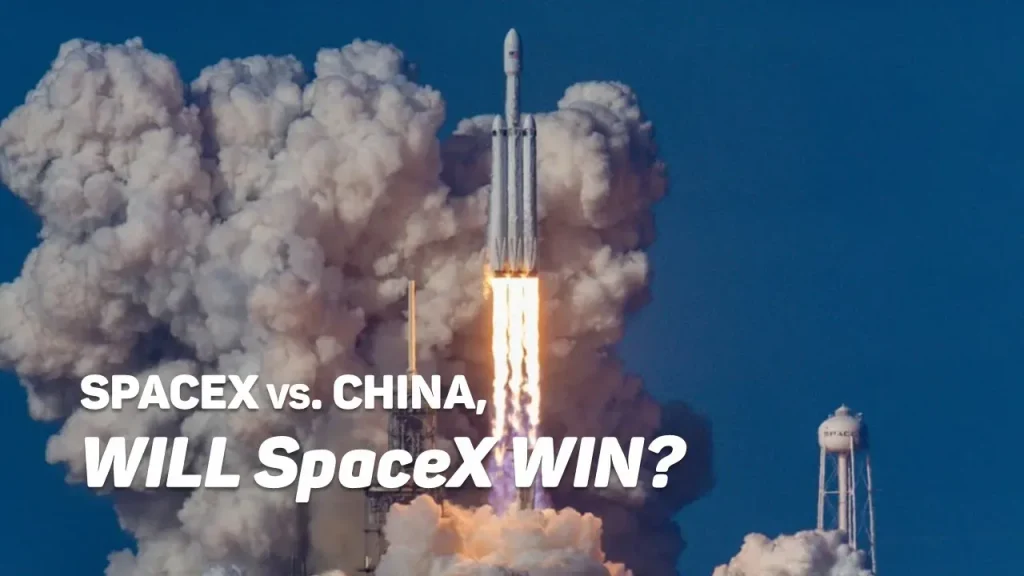In the evolving landscape of the space race 2025, **China vs SpaceX** is emerging as a notable rivalry that has captured global attention. SpaceX, with its impressive fleet of nearly 8,000 Starlink satellites, has set a high bar for internet connectivity from low-Earth orbit, creating a significant challenge for China’s ambitions. The Chinese space program has made remarkable strides; however, it currently fields only 124 internet-providing satellites, raising concerns over its ability to keep pace in this military space competition. The urgency for China to expand its satellite capabilities is fueled by perceived threats from SpaceX’s dominance in the satellite internet sector. As both powers navigate the complexities of space technology and geopolitical tensions, the implications for the future of global communication and military strategies become increasingly evident.
In the modern quest for space supremacy, the competition between **China and SpaceX** signifies crucial developments in aerospace technology and strategic military interests. The ongoing battle for leadership in satellite internet infrastructure not only involves the vast deployment of Starlink satellites but also encompasses China’s overarching ambitions to elevate its own space capabilities. With both nations investing heavily in their respective space programs, the stakes have transformed into a pivotal contest for technological innovation and global influence. The disparity in satellite count highlights a significant hurdle for China, which must overcome to establish itself as a formidable player in the arena of space-based technological solutions. As we delve deeper into this rivalry, understanding the implications of such advancements is vital for grasping the future of national and international space policies.
The Intensifying Space Race: China vs. SpaceX
As we advance into the mid-2020s, the cosmic showdown between China and SpaceX has intensified, marking a new era in the ongoing space race. With China’s strategic focus on enhancing its space capabilities, the nation views the proliferation of SpaceX’s nearly 8,000 Starlink satellites as a significant military threat. This satellite Internet constellation offers unrivaled global broadband service that challenges China’s own ambitions to deliver satellite-based internet access. The competition is not just about technological advancements; it symbolizes a larger duel for dominance in the military and technological realms on a global scale.
China’s response has been to elevate its space initiatives, with the expressed goal of catching up to SpaceX’s massive Starlink network. Despite some initial success in launching a range of satellites, the reality is stark: as of July 2025, the Chinese space program is lagging, having deployed only 124 Internet-providing satellites. This shortfall is a clear indication of the challenges China faces in its quest to establish a robust satellite internet infrastructure that can compete with that of SpaceX.
China’s Strategic Push in Space Exploration
In its race against SpaceX, China has doubled down on its investment in domestic space projects, with a focus on not only internet satellites but also broader capabilities in space exploration and technology. The Chinese space program’s ambitions include robust modules for permanent space stations, lunar explorations, and Mars missions, which have stirred global interest. The government views these advancements as crucial for asserting its presence not just in Earth’s orbit but also in deeper space exploration, an area where SpaceX has also shown considerable promise.
However, aspiring to catch up with SpaceX means that China must also work on integrating a network of Starlink-like satellites into its arsenal. Observers note that such expansion could have dual-use technologies that benefit both civilian and military sectors, further complicating the global military space competition. This dual focus highlights the necessity for an integrated approach to space innovation and the geopolitical implications of satellite technology within an ever more connected global landscape.
Military Aspects of the Space Race: Strategic Implications
The military implications of the burgeoning satellite networks led by SpaceX cannot be overstated. The U.S. government’s perception of SpaceX’s Starlink network is not merely as a data provider but as a potential vector for military communication and strategic spatial awareness. China recognizes this and has embedded its space ambitions within a military framework as it strives to emulate and potentially surpass SpaceX’s achievements in satellite launches.
As both China and SpaceX enhance their satellite networks, the military space competition is set to escalate. Each side is wary of the other’s capabilities, with China responding to perceived threats by ramping up its satellite production and enhancing its military readiness. The outcomes of this race will not only shape international relations but also determine the control of future global communications and space resource management.
Starlink Satellites and Their Global Impact
Starlink satellites represent a revolutionary advancement in global communications, enabling high-speed internet access in even the most remote locations. The extensive network created by SpaceX signifies a paradigm shift in how technology can bridge geographical divides and foster connectivity. As nations like China observe the implications of such technology, it compels them to reconsider their approaches to satellite communications, particularly given the network’s potential military applications.
For countries not only limited to the U.S. and China, SpaceX’s Starlink has opened the door for international partnerships and competitiveness in satellite services. The emergence of such platforms can significantly alter existing paradigms of market dominance and influence in the digital economy, especially as more nations realize the power of space-based internet services in expanding their technological frontiers and enhancing their military communications.
Challenges Facing China’s Space Program
Despite its ambitious goals, China’s space program grapples with a myriad of challenges that hinder its ability to rapidly catch up with SpaceX. Limited experience in deploying large-scale satellite constellations means that their operational readiness and maintenance protocols may not be as solidified as those cultivated by years of SpaceX’s operational experience. Moreover, inefficient regulatory and logistical frameworks can delay satellite launches and development, posing barriers to timely escalation of their capabilities.
As competition heats up, China must also grapple with international scrutiny and potential sanctions related to its military applications of space technologies. As the global community increasingly connects technological advancement with national security, China’s space endeavors are evaluated through a lens that blends technological and military capacity, complicating its efforts to enter partnerships and collaborations that could bolster its position.
Future Prospects: The Next Steps in the Space Race
Looking ahead, the future of the China vs. SpaceX space race is fraught with possibilities. As countries allocate more resources towards their space ambitions, the narrative will be shaped by both technological advancements and the geopolitical landscape. There’s a continuous need for innovation, with both players investing in the next generation of satellite technologies and exploration missions that could redefine current limitations and extend capabilities.
Moreover, the notion of a collaborative versus competitive space framework could materialize, depending on how leadership responds to the burgeoning capabilities of private enterprises like SpaceX. The benefits of collaboration in areas like satellite technology and deep space missions against a backdrop of sharing knowledge could potentially outweigh adversarial stances, leading to new cooperative ventures that redefine international space law and exploration.
Harnessing Technological Innovations in Space
Technological advancements are at the core of the space race, with both China and SpaceX pushing the envelope in satellite design, launch capabilities, and operational efficiencies. Innovations such as reusable rocket technology, AI-driven satellite deployments, and improved communication protocols serve as game-changers in how space is explored and exploited. These technologies not only drive down costs but also enhance the frequency and reliability of launches, giving a competitive advantage to those who can harness them effectively.
For China to effectively compete, it must invest not only in hardware but also in research and development to create a robust ecosystem that supports advanced space technologies. The integration of AI and machine learning into satellite operations can facilitate better data analysis and operational management, an area where SpaceX has already made significant advancements. Adopting similar or improved technologies could help China leapfrog its current capabilities and respond more effectively to emerging threats in this evolving panorama of military space competition.
The Global Role of Military Space Competition
Military space competition extends beyond just China and SpaceX; it sets the stage for how global power dynamics will unfold in the coming decades. The presence of multiple players vying for supremacy in space could lead to a fragmented approach to space governance, with nations looking to secure their own interests while potentially undermining global cooperation. As technological advancements proliferate, so do the risks associated with militarizing space, prompting debates about the need for comprehensive international agreements.
Countries may find themselves compelled to adapt or even enhance their military space strategies in response to capabilities demonstrated by competitors like SpaceX. As this landscape evolves, the necessity for transparency and responsible behavior in space becomes increasingly critical, particularly when military assets become intertwined with commercial projects, impacting civilian life on Earth and the sustainability of space activities.
Innovation and Competition: Lessons from the Space Race
The lessons learned from the evolving competition between SpaceX and China are numerous, particularly around the importance of fostering an innovative culture that can withstand the pressures of global competition. Agility and the ability to pivot in technology development stand as primary factors that can distinguish successful space initiatives from those that stagnate. As SpaceX continues to demonstrate, the ability to rapidly test and implement new ideas can lead to groundbreaking advancements.
China’s response to the lessons learned from SpaceX’s successes will be pivotal in defining its future trajectory. Embracing innovation, fostering talent, and enhancing public-private partnerships in the space sector can drive China’s next steps in securing its place in the global arena. As this space race unfolds, the capacity for nations to adapt and embrace change will undoubtedly shape the outcome and establish new benchmarks for success in the years to come.
Frequently Asked Questions
What is the significance of the space race 2025 between China and SpaceX?
The space race 2025 between China and SpaceX is significant as it highlights the global competition in space technology and satellite deployment. As SpaceX leads with nearly 8,000 Starlink satellites providing global internet service, China’s ambition to catch up reflects its strategic focus on enhancing its space capabilities and addressing perceived military threats.
How does China’s space program compare to SpaceX’s satellite capabilities?
China’s space program, while advancing in various areas, currently lags behind SpaceX in satellite deployment for internet services. SpaceX operates around 8,000 Starlink satellites, whereas China has only launched 124 internet-providing satellites. This gap raises concerns for China regarding its operational and strategic positioning in the global space landscape.
What are the military implications of the competition between China and SpaceX in space?
The military implications of the competition between China and SpaceX in space center around the deployment of internet satellites. China perceives SpaceX’s vast network of Starlink satellites as a potential military threat, which underlines the importance of achieving satellite parity to ensure national security and maintain technological sovereignty.
How do Starlink satellites influence the space race between China and SpaceX?
Starlink satellites play a crucial role in the space race between China and SpaceX by setting a benchmark for internet accessibility from space. The extensive deployment of Starlink satellites not only enhances connectivity but also showcases SpaceX’s technological prowess, compelling China to accelerate its satellite development and address the competitive landscape.
What challenges does China face in catching up to SpaceX’s internet satellites?
China faces several challenges in catching up to SpaceX’s internet satellites, including technological constraints, regulatory hurdles, and the limited number of satellites currently deployed. With only 124 internet-providing satellites, China’s ability to scale its capabilities quickly is hindered, making the competition in the space race increasingly complex.
What are the future prospects for China vs SpaceX in the military space competition?
The future prospects for China vs SpaceX in the military space competition are dynamic, as both entities continue to innovate and invest in their space programs. China’s goal to enhance its satellite capabilities could lead to breakthroughs, while SpaceX’s established infrastructure may fortify its lead. The outcome will depend on advancements in technology, policy decisions, and international collaboration.
| Key Points |
|---|
| China has focused on advancing its space program to compete with SpaceX, particularly in satellite technology. |
| SpaceX has a significant advantage with nearly 8,000 Starlink satellites in low-Earth orbit. |
| China currently operates only 124 internet-providing satellites, indicating a substantial gap. |
| China views the expansion of Starlink as a military threat, motivating its urgent efforts in satellite deployment. |
| Successes in other areas of China’s space program do not fully compensate for the lag in number of operational satellites. |
Summary
In the ongoing battle of China vs SpaceX, the dynamics of global space competition have intensified as China strives to catch up with SpaceX’s massive fleet of Starlink satellites. This strategic race highlights the significant differences in satellite deployment, with SpaceX leading by a vast margin. China’s focus on bolstering its satellite capabilities is not just about economic advantages; it also stems from military considerations. While both nations have made strides in their respective space endeavors, the stark contrast in the number of operational satellites underscores the challenges China faces in this new age of space exploration.



